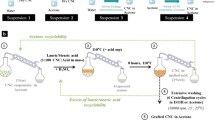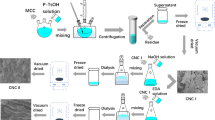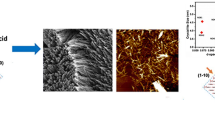Abstract
The morphological properties of nano cellulosic materials affect their industrial applications significantly. Solvents are commonly used in treating cellulosic materials in altered applications. In this work, the treatment of cellulose nanocrystals (CNCs) with dimethyl sulfoxide (DMSO) (99.5%) and N-methyl morpholine-N-oxide (NMMO) (50%) was investigated comprehensively under different conditions to evaluate the effect of solvent treatment on the properties of CNCs. A partial polymorphic transition of cellulose I to II was observed when CNCs were treated with the solvents. The temperature of the treatment was more influential than the time of the treatment in altering the CNC properties. XRD, light scattering, and wettability analyses confirmed that the partial dissolution of CNCs in solvents reordered the cellulosic chains from parallel to antiparallel. It also made more hydroxyl groups accessible on CNCs for hydrogen bonding, facilitating the CNC aggregation and instability in solutions. The XPS analysis revealed a remarkable alteration in the relative amounts of components in C 1s, reflecting transformation in the chemical bonds from C=O/O–C–O to C–O on the CNC surface. The increase in the hydroxyl group of CNCs also improved the water-uptake and hydrophilicity of CNCs when they were treated with solvents. The results of this work would suggest that the alteration in the CNC characteristics should be considered when selecting solvents for developing industrial applications for CNCs.






Similar content being viewed by others
Availability of data and material
Raw data of this work can be available upon request from the corresponding author.
References
Aguayo M, Fernández Pérez A, Reyes G, Oviedo C, Gacitúa W, Gonzalez R, Uyarte O (2018) Isolation and characterization of cellulose nanocrystals from rejected fibers originated in the kraft pulping process. Polymers 10(10):1145–1156
Arnata IW, Suprihatin S, Fahma F, Richana N, Sunarti TC (2020) Cationic modification of nanocrystalline cellulose from sago fronds. Cellulose 27(6):3121–3141
Askadskii A, Popova M, Matseevich T, Kurskaya E (2014) The Influence of the degree of crystallinity on the glass transition temperature of polymers. Adv Mater Res 864:751–754
Banerjee M, Saraswatula S, Williams A, Brettmann B (2020) Effect of purification methods on commercially available cellulose nanocrystal properties and TEMPO Oxidation. Processes 8(6):698–712
Beck-Candanedo S, Roman M, Gray DG (2005) Effect of reaction conditions on the properties and behavior of wood cellulose nanocrystal suspensions. Biomacromolecules 6(2):1048–1054
Benselfelt T, Cranston ED, Ondaral S, Johansson E, Brumer H, Rutland MW, Wågberg L (2016) Adsorption of xyloglucan onto cellulose surfaces of different morphologies: an entropy-driven process. Biomacromolecules 17(9):2801–2811
Biganska O, Navard P (2003) Phase diagram of a cellulose solvent: N-methylmorpholine–N-oxide–water mixtures. Polymer 44(4):1035–1039
Biganska O, Navard P (2009) Morphology of cellulose objects regenerated from cellulose-N-methylmorpholine N-oxide-water solutions. Cellulose 16(2):179–188
Casarano R, Pires PA, Borin AC, El Seoud OA (2014) Novel solvents for cellulose: use of dibenzyldimethylammonium fluoride/dimethyl sulfoxide (DMSO) as solvent for the etherification of the biopolymer and comparison with tetra (1-butyl) ammonium fluoride/DMSO. Ind Crops Prod 54:185–191
Chen D, van de Ven TG (2016) Flocculation kinetics of precipitated calcium carbonate (PCC) with sterically stabilized nanocrystalline cellulose (SNCC). Coll Surf A 506:789–793
Costa LA, Fonseca AF, Pereira FV, Druzian JI (2015) Extraction and characterization of cellulose nanocrystals from corn stover. Cell Chem Technol 49(2):127–133
Dankovich TA, Gray DG (2011) Contact angle measurements on smooth nanocrystalline cellulose (I) thin films. J Adhes Sci Technol 25(6–7):699–708
Dong S, Bortner MJ, Roman M (2016) Analysis of the sulfuric acid hydrolysis of wood pulp for cellulose nanocrystal production: a central composite design study. Ind Crops Prod 93:76–87
Douard L, Bras J, Encinas T, Belgacem N (2020) Natural acidic deep eutectic solvent to obtain cellulose nanocrystals using the design of experience approach. Carbohydr Polym 252:117136–117145
El-Wakil NA, Hassan ML (2008) Structural changes of regenerated cellulose dissolved in FeTNa, NaOH/thiourea, and NMMO systems. J Appl Pol Sci 109(5):2862–2871
Fatona A, Berry RM, Brook MA, Moran-Mirabal JM (2018) Versatile surface modification of cellulose fibers and cellulose nanocrystals through modular triazinyl chemistry. Chem Mater 30(7):2424–2435
Feizi ZH, Fatehi P (2020) Carboxymethylated cellulose nanocrystals as clay suspension dispersants: effect of size and surface functional groups. Cellulose 27:3759–3772
Feizi ZH, Fatehi P (2021) Interaction of hairy carboxyalkyl cellulose nanocrystals with cationic surfactant: Effect of carbon spacer. Carbohydr Polym 255:117396–117407
Feizi ZH, Kazzaz AE, Kong F, Fatehi P (2019) Evolving a flocculation process for isolating lignosulfonate from solution. Sep Purif Technol 222:254–263
French AD (2014) Idealized powder diffraction patterns for cellulose polymorphs. Cellulose 21(2):885–896
French AD (2020) Increment in evolution of cellulose crystallinity analysis. Cellulose 27:5445–5448
Glińska K, Lerigoleur C, Giralt J, Torrens E, Bengoa C (2020) Valorization of cellulose recovered from WWTP sludge to added value levulinic acid with a Brønsted acidic ionic liquid. Catalysts 10(9):1004–1020
Habibi Y, Lucia LA, Rojas OJ (2010) Cellulose nanocrystals: chemistry, self-assembly, and applications. Chem Rev 110(6):3479–3500
Hambardzumyan A, Foulon L, Chabbert B, Aguié-Béghin V (2012) Natural organic UV-absorbent coatings based on cellulose and lignin: designed effects on spectroscopic properties. Biomacromolecules 13(12):4081–4088
Han J, Zhou C, Wu Y, Liu F, Wu Q (2013) Self-assembling behavior of cellulose nanoparticles during freeze-drying: effect of suspension concentration, particle size, crystal structure, and surface charge. Biomacromolecules 14(5):1529–1540
Hauru LK, Hummel M, King AW, Kilpelainen I, Sixta H (2012) Role of solvent parameters in the regeneration of cellulose from ionic liquid solutions. Biomacromolecules 13(9):2896–2905
Herrera-Morales J, Morales K, Ramos D, Ortiz-Quiles EO, Lopez-Encarnacion JM, Nicolau E (2017) Examining the use of nanocellulose composites for the sorption of contaminants of emerging concern: an experimental and computational study. ACS Omega 2(11):7714–7722
Islam MIU, Sherrell R, Langrish TAG (2010) An investigation of the relationship between glass transition temperatures and the crystallinity of spray-dried powders. Dry Technol 28(3):361–368
Jia X, Chen Y, Shi C, Ye Y, Wang P, Zeng X, Wu T (2013) Preparation and characterization of cellulose regenerated from phosphoric acid. J Agric Food Chem 61(50):12405–12414
Jiang Z, Tang L, Gao X, Zhang W, Ma J, Zhang L (2019) Solvent regulation approach for preparing cellulose-nanocrystal-reinforced regenerated cellulose fibers and their properties. ACS Omega 4(1):2001–2008
Jin E, Guo J, Yang F, Zhu Y, Song J, Jin Y, Rojas OJ (2016) On the polymorphic and morphological changes of cellulose nanocrystals (CNC-I) upon mercerization and conversion to CNC-II. Carbohydr Polym 143:327–335
Johnson A, Jones A (2019) Testing for water in DMSO: exploring alternatives to volumetric karl fischer analysis. Pharm Technol 43(5):44–48
Ju X, Bowden M, Brown EE, Zhang X (2015) An improved X-ray diffraction method for cellulose crystallinity measurement. Carbohydr Polym 123:476–481
Kaboorani A, Riedl B (2015) Surface modification of cellulose nanocrystals (CNC) by a cationic surfactant. Ind Crop Prod 65:45–55
Kazzaz AE, Feizi ZH, Kong F, Fatehi P (2018a) Interaction of poly (acrylic acid) and aluminum oxide particles in suspension: particle size effect. Colloid Surf A 556:218–226
Kazzaz AE, Feizi ZH, Fatehi P (2018b) Interaction of sulfomethylated lignin and aluminum oxide. Colloid Polym Sci 296(11):1867–1878
Kim HC, Mun S, Ko HU, Zhai L, Kafy A, Kim J (2016) Renewable smart materials. Smart Mater Struct 25(7):073001. https://doi.org/10.1088/0964-1726/25/7/073001
King AW, Mäkelä V, Kedzior SA, Laaksonen T, Partl GJ, Heikkinen S, Koskela H, Heikkinen HA, Holding AJ, Cranston ED, Kilpeläinen I (2018) Liquid-state NMR analysis of nanocelluloses. Biomacromolecules 19(7):2708–2720
Krysztof M, Olejnik K, Kulpinski P, Stanislawska A, Khadzhynova S (2018) Regenerated cellulose from N-methylmorpholine N-oxide solutions as a coating agent for paper materials. Cellulose 25(6):3595–3607
Laitinen O, Ojala J, Sirviö JA, Liimatainen H (2017) Sustainable stabilization of oil in water emulsions by cellulose nanocrystals synthesized from deep eutectic solvents. Cellulose 24(4):1679–1689
Li F, Biagioni P, Bollani M, Maccagnan A, Piergiovanni L (2013) Multi-functional coating of cellulose nanocrystals for flexible packaging applications. Cellulose 20(5):2491–2504
Li Y, Wang J, Liu X, Zhang S (2018) Towards a molecular understanding of cellulose dissolution in ionic liquids: anion/cation effect, synergistic mechanism and physicochemical aspects. Chem Sci 9(17):4027–4043
Lin N, Dufresne A (2014) Surface chemistry, morphological analysis and properties of cellulose nanocrystals with gradiented sulfation degrees. Nanoscale 6(10):5384–5393
Man Z, Muhammad N, Sarwono A, Bustam MA, Kumar MV, Rafiq S (2011) Preparation of cellulose nanocrystals using an ionic liquid. J Polym Environ 19(3):726–731
Maurer JJ (1965) Relation between glass transition temperature and composition of ethylene propylene copolymers. Rubber Chem Technol 38(4):979–990
Medronho B, Lindman B (2014) Competing forces during cellulose dissolution: from solvents to mechanisms. Curr Opin Colloid Interface Sci 19(1):32–40
Moriana R, Vilaplana F, Ek M (2016) Cellulose nanocrystals from forest residues as reinforcing agents for composites: a study from macro-to nano-dimensions. Carbohydr Polym 139:139–149
Ng HM, Sin LT, Tee TT, Hui BST, D, Low CY, Rahmat AR, (2015) Extraction of cellulose nanocrystals from plant sources for application as reinforcing agent in polymers. Compos B Eng 75:176–200
Poletto M, Pistor V, Zattera AJ (2013) Chapter 2: Structural characteristics and thermal properties of native cellulose. In: van de Ven T (ed) Cellulose fundamental aspects. Intech publisher, pp 45–68
Rabideau BD, Ismail AE (2015) Effect of water content in N-methylmorpholine N-oxide/cellulose solutions on thermodynamics, structure, and hydrogen bonding. J Phys 119(48):15014–15022
Reid MS, Villalobos M, Cranston ED (2017) The role of hydrogen bonding in non-ionic polymer adsorption to cellulose nanocrystals and silica colloids. Curr Opp Colloid Interf Sci 29:76–82
Samsudin NA, Low FW, Yusoff Y, Shakeri M, Tan XY, Lai CW, Asim N, Newas KS, Tiong SK, Amin N (2020) Effect of temperature on synthesis of cellulose nanoparticles via ionic liquid hydrolysis process. J Mol Liq 308:113030–113037
Segal L, Creely JJ, Martin AE, Conrad CM (1959) An empirical method for estimating the degree of crystallinity of native cellulose using the X-ray diffractometer. Text Res J 29(10):786–794
Semin DJ, Malone TJ, Paley MT, Woods PW (2005) A novel approach to determine water content in DMSO for a compound collection repository. J Biomol Screen 10(6):568–572
Sharma S, Zhang X, Nair SS, Ragauskas A, Zhu J, Deng Y (2014) Thermally enhanced high performance cellulose nano fibril barrier membranes. RSC Adv 4(85):45136–45142
Sirviö JA (2019) Fabrication of regenerated cellulose nanoparticles by mechanical disintegration of cellulose after dissolution and regeneration from a deep eutectic solvent. J Mater Chem A 7(2):755–763
Sriamornsak P, Wattanakorn N, Nunthanid J, Puttipipatkhachorn S (2008) Mucoadhesion of pectin as evidence by wettability and chain interpenetration. Carbohydr Polym 74(3):458–467
Viet D, Beck-Candanedo S, Gray DG (2007) Dispersion of cellulose nanocrystals in polar organic solvents. Cellulose 14(2):109–113
Wan Y, An F, Zhou P, Liu Y, Lu C, Chen H (2017) Effect of the polymorphs of cellulose on its pyrolysis kinetic and char yield. J Anal Appl Pyrolysis 127:223–228
Wan Ishak WH, Ahmad I, Ramli S, Mohd Amin MCI (2018) Gamma irradiation-assisted synthesis of cellulose nanocrystal-reinforced gelatin hydrogels. Nanomaterials 8(10):749–762
Yang X, Wang X, Liu H, Zhao Y, Jiang S, Liu L (2017) Impact of dimethyl sulfoxide treatment on morphology and characteristics of nanofibrillated cellulose isolated from corn husks. BioResources 12(1):95–106
Yao W, Weng Y, Catchmark JM (2020) Improved cellulose X-ray diffraction analysis using fourier series modeling. Cellulose 27(10):5563–5579
Yue Y, Zhou C, French AD, Xia G, Han G, Wang Q, Wu Q (2012) Comparative properties of cellulose nano-crystals from native and mercerized cotton fibers. Cellulose 19(4):1173–1187
Zainuddin N, Ahmad I, Kargarzadeh H, Ramli S (2017) Hydrophobic kenaf nanocrystalline cellulose for the binding of curcumin. Carbohydr Polym 163:261–269
Zhang D, Karkooti A, Liu L, Sadrzadeh M, Thundat T, Liu Y, Narain R (2018) Fabrication of antifouling and antibacterial polyethersulfone (PES)/cellulose nanocrystals (CNC) nanocomposite membranes. J Membr Sci 549:350–356
Zhao H, Kwak JH, Wang Y, Franz JA, White JM, Holladay JE (2007) Interactions between cellulose and N-methylmorpholine-N-oxide. Carbohydr Polym 67(1):97–103
Zielińska A, Martins-Gomes C, Ferreira NR, Silva AM, Nowak I, Souto EB (2018) Anti-inflammatory and anti-cancer activity of citral: optimization of citral-loaded solid lipid nanoparticles (SLN) using experimental factorial design and LUMiSizer®. Int J Pharm 553(1–2):428–440
Funding
The funding support of this work was provided by NSERC, Canada Foundation for Innovation, and Canada Research Chairs programs.
Author information
Authors and Affiliations
Contributions
ZHF: raw data, method, concept, first draft; PF: revision, supervision.
Corresponding author
Ethics declarations
Conflict of interest
The authors declare no conflict of interest, and both authors approved the publication of this paper.
Human or animal rights
This article does not contain any studies with human participants or animals.
Additional information
Publisher's Note
Springer Nature remains neutral with regard to jurisdictional claims in published maps and institutional affiliations.
Supplementary Information
Below is the link to the electronic supplementary material.
Rights and permissions
About this article
Cite this article
Feizi, Z.H., Fatehi, P. Changes in the molecular structure of cellulose nanocrystals upon treatment with solvents. Cellulose 28, 7007–7020 (2021). https://doi.org/10.1007/s10570-021-03972-x
Received:
Accepted:
Published:
Issue Date:
DOI: https://doi.org/10.1007/s10570-021-03972-x




